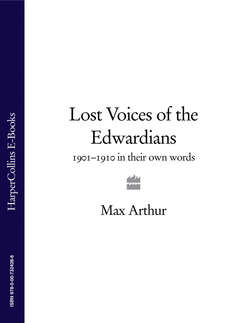Читать книгу Lost Voices of the Edwardians: 1901–1910 in Their Own Words - Max Arthur, Max Arthur - Страница 5
ОглавлениеPROLOGUE END OF AN ERA
Jim Davies
We lived in Windsor and I used to see Queen Victoria quite often on her terrace with her two Indian attendants. I suppose I was four years old. My father was a great patriot, but to me she was an old woman in a black bonnet.
Kitty Marion
On 22 January 1901, the manager of the Opera House, Cheltenham, announced to the audience the news of Queen Victoria's death. People listened and quietly dispersed. It seemed as if the world stood still and could never continue without the Queen. However, the following day King Edward VII was proclaimed King and life went on as usual.
Arthur Harding
It was the most extraordinary thing. Everybody – the children as well – wore black. Everyone was in mourning. Even poor little houses that faced onto the street put a board up and painted it black. All the shops had black shutters up and everyone felt as if they'd lost somebody. It was extraordinary that people who were starving for the best part of their lives should mourn the old Queen. I was a bit of a rebel and I couldn't really understand it.
Clement Williams
In 1901 I was in the Oxfordshire Light Infantry and I was present at Queen Victoria's funeral. The day was bitterly cold. It was snowing hard and we had to leave Oxford at five o'clock to get there in time. We caught the train, but there were no heated carriages in those days. When we arrived at Slough, seeing that we had plenty of time in hand, our commanding officer sent us on a twelve-mile march to warm us up. We marched into Windsor, where we were given a tin mug of beer and a pork pie. Then we stood about and waited until the ceremony began. We lined the route to St George's Chapel but we had nothing to do because the crowds weren't allowed there. It was very interesting to see Queen Alexandra, the Prince of Wales and the two little boys in sailor suits, as they arrived. Trouble began when the coffin arrived on the train. The coffin was supposed to be placed on a gun carriage to be pulled to the castle by horses. The train was late and the day was cold, but with the excitement of all the comings and goings, the horses simply wouldn't move. They didn't like it and were jumping and kicking about, and looked as if they were going to upset the whole thing, so they were taken out of their harnesses. The carriage was supposed to be followed by a Naval Guard of Honour, and a naval officer came forward and suggested that his men be put in place of the horses. The sailors were harnessed onto the gun carriage and they hauled the coffin up the hill right the way up to the castle. Of course, it took them a long time to pull the carriage all that way, and in the meantime, everyone was waiting. We knew by the salute guns that the coffin must have arrived at Windsor, but it was taking a long time to reach the castle. Time went by and I saw Earl Clarendon, the chap in charge of the ceremony – he kept coming out and looking down the road, wondering why nobody came. You could hear a band in the distance but nothing was happening. Then Queen Alexandra came tearing out, looking this way and that way, before Clarendon persuaded her to go back into the Chapel. Finally, the carriage came along very slowly, hauled along by the Navy. After the ceremony, King Edward VII appeared on the steps of St George's Chapel. He stood with the Kaiser and we gave them the royal salute. They saluted us back. Then they went off and we packed up and went home.
Nina Halliday
We saw the procession from a stand which had been erected under the Guildhall. The seats were covered in black material and everyone wore black clothes, but I had a dress, coat and hat of a lovely mauve colour – I loved it. The streets were lined by Foot Guards and the pavements were packed tight with people all dressed in black. It was a long wait, as the train bringing the coffin and all the important people travelled very slowly from Paddington to Windsor – so that people at the stations which it passed could see it.
It was a wonderful procession, with the Life and Foot Guards playing the Dead March. The Guard of Honour led; then came the gun carriage covered by the Royal Standard. The new King, Edward VII, followed with many of the Queen's relations and Kings and Princes all in uniform. The finest was the Emperor of Germany in a beautiful white uniform and white helmet with lots of gold on it, and many Orders and decorations. Then came the chiefs of the Navy and Army and members of the Queen's Household, followed by members of the Queen's Court, including her daughters and other relations in royal carriages – all, of course, in black with long veils.
I seem to remember that a purple cushion was on the coffin with a small crown on it. The bands had muffled drums and as the procession came along, one could hear the slow booming of the guns. All very solemn, so much black and such a small coffin – but so much colour as well, with so many uniforms.
George Lappage
My chum and I led the procession into Windsor Castle. When that was over, we went back to barracks and that night three troopers and an officer were told to go up to Windsor Castle and do sentry over the Queen's body. I was posted just outside the Chapel door.
